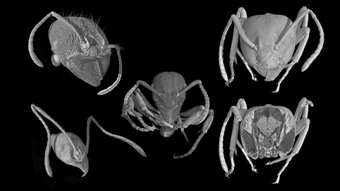Automated Volumetric Interpretation
Scientific Big Data Analytics (SBDA) techniques can be used for Automated Volumetric Interpretation of time-resolved imaging of materials and biological specimen to provide deep insight into dynamics of bacterial cells, composite materials, or living organisms, among others. Experiments are coming from X-ray imaging at synchrotrons or free-electron lasers. The quality of automated segmentation and interpretation algorithms will strongly increase with the amount of available data combined with SBDA techniques to harvest and mine prior information from similar experiments across facilities and disciplines. To maximize the sample size, we aim to exploit the vast amount of imaging data available in the Helmholtz Data Centers as well as the PaNdata collaboration, which includes almost all European Photon and Neutron sources, and also collaborations with various other light sources, particularly in the USA. The interpretation of 3D-data by volumetric segmentation and interpretation can greatly benefit from SBDA by harvesting and mining prior information from similar experiments across facilities and disciplines.
Collaborative Data Mining on Volumetric Data of Ants
 Examples of ant species recorded at PETRA III for collaborative analysis. - Source: https://ufo.kit.edu/dis/index.php/project/nova/
Examples of ant species recorded at PETRA III for collaborative analysis. - Source: https://ufo.kit.edu/dis/index.php/project/nova/
- The NOVA project: Maximizing beam time efficiency through synergistic analyses of SRμCT data - Schmelzle S. et al., in Proceedings of SPIE - The International Society for Optical Engineering, 10391 (2017), 103910P.
- Enhancing a diffusion algorithm for 4D image segmentation using local information - Losel P., Heuveline V., in Progress in Biomedical Optics and Imaging - Proceedings of SPIE, 9784 (2016), 97842L.
This use case is contributed by Deutsches Elektronen-Synchrotron (Desy).
